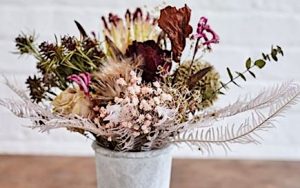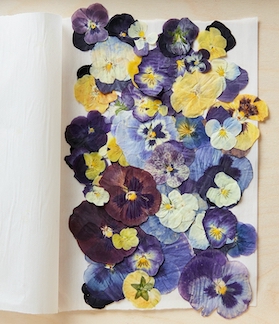Flower Preservation Methods with A Modern Twist!
By Elizabeth C. Fake, Fairfax Master Gardener
 At the end of summer with the first frost, we’ll lose the beautiful garden flowers we’ve relished all summer. We can enjoy garden flowers year-round by preserving them and bringing them inside as dried flower arrangements, bouquets, nosegays, wreaths, garlands, ornaments, pressed flower pictures, resin jewelry, teas, potpourris or whatever else you can imagine.
At the end of summer with the first frost, we’ll lose the beautiful garden flowers we’ve relished all summer. We can enjoy garden flowers year-round by preserving them and bringing them inside as dried flower arrangements, bouquets, nosegays, wreaths, garlands, ornaments, pressed flower pictures, resin jewelry, teas, potpourris or whatever else you can imagine.
There are some general guidelines to follow to select and prepare flowers for preservation. Collect flowers that have just reached full bloom and are in peak condition in the mid-morning after the dew has dried. Rather than hand pick, use scissors or pruning shears to cut the flowers on a slant leaving stems about 6 inches long. Remove leaves as they don’t dry well. To prevent mold, gently dry the blossoms or plant material with a paper towel to make sure they are thoroughly dry. Now, work quickly to make sure you preserve the flowers at their peak beauty.

Globe Amaranth
Drying
Traditional drying methods are hang and dry, use of chemical drying agents and flower pressing. Hang and dry is one of the easiest and least expensive ways to preserve flowers. Good candidates for hang and dry are robust flowers including Artemisia, Baby’s Breath, Globe Amaranth, Liatris, Blackberry Lily, Carnations, Cattail, Celosia, Chinese Lantern, Coreopsis, Dock, Gerber Daisies, Goldenrod, Heather, Hydrangeas, Lavender, Pussywillow, Roses, Statice, Strawflower and Yarrow. Wildflowers make good candidates for hang and dry as well. Gather the stems into 10 to 12 stem bunches and tie together with a piece of natural twine. Hang upside down in a warm, dark place like an attic or backroom closet where darkness will help preserve the colors. Allow two weeks for complete drying.
Chemical
Chemical drying gives the best results for long lasting dried flower arrangements, basket arrangements, wreaths, art projects or whenever you want flowers to look as natural as possible. Chemical agents include a number of desiccant substances that are widely available and inexpensive such as saw dust, borax, talcum powder, cornstarch, cornmeal, silica gel, sand and kitty litter. Floral professionals, however, use a commercial product named Silica Gel, which is commonly available at hobby shops or garden centers. Compared to other desiccants, it is expensive, but ensures the flowers retain their color and shape. It can be used repeatedly if kept dry and clean.

Roses in silica gel
Good candidates for chemical drying include African Violet, Bleeding Heart, Coneflower, Dahlia, Daylily, Iris, Peony, Snapdragon and Zinnia. Regardless of drying agent, you will need a large container with a tight-fitting lid for chemical drying. Cover the bottom of the container with about 1 inch (2 cm) of the drying substance, arrange the flowers upright in the container and sprinkle the rest of the substance over the top of the flowers covering the petals and inside and around the flower. Seal the container tightly and place in a storage area such as an attic or closet where the container will not be disturbed. Leave for five to seven days or until the flowers are thoroughly dry. Shake off the drying substance, filter out any debris and save for another time. Store flowers in the container until ready for use.
Pressing

Pressed pansies
Pressing flowers is the best way to preserve flowers and leaves for artwork and framing in glass. This requires a large, heavy book, such as a phone book. Professionals use wooden plant presses which you can buy at a reasonable price online from hobby shops or other vendors. The best candidates for pressing include flat faced plant material such as Violets, Pansies, Larkspur, Ferns, autumn tree leaves, Ageratum, Butterfly Weed, Coral Bells and Heliotrope. Begin pressing by opening the book or flower press and lay down a layer of newsprint on a page in the middle of the book. Then add absorbent paper on top to cushion the plant material. Lay the flowers flat exactly as you want in the picture and add another layer of paper toweling, tissue paper or parchment paper on top. Finish with a final layer of newsprint. Close the book or press and move to a closet or corner where it will be undisturbed. Weigh down the book cover with something heavy that is as big as the book, such as a heavy cutting board, rocks or bricks. A wooden press will have its own weighting device which should be fully deployed to make a tight seal. Keep materials in the press for three to four weeks until they are dry. Remove with care as they are thin and break easily.
Flower preservation has improved in the 21st century with the advent of the microwave oven, food dehydrator and the development of vegetable glycerin. Overall, the time for drying has decreased from weeks to minutes. For microwave drying, begin by laying a paper towel on top of the glass plate in the microwave. Lay each individual flower blossom on the paper towel so it is not touching any other flower. Lay a piece of paper towel on top of flowers and top with a piece of parchment paper. Put something heavy and microwaveable on top of the stack such as a cutting board, tile or ceramic plate, as long as it is heavy enough to press the flowers and exert equal pressure. The amount of time needed for drying depends on the type of flower. Small flowers such as Pansies, Violas, Baby’s Breath, Buttercup, Feverfew, Heather, Ferns and other open-faced flowers dry quickly. Microwave at ½ power for 1.5 to 2 minutes until they are crisp. Add 30 seconds more if the flowers are still pliable. For larger flowers such as Azalea, Calendula, Daisy, Aster, Bachelor Button, Larkspur, Delphinium or Fox Glove, allow 2 to 3 minutes at ½ power for processing.
The food dehydrator preserves whole flowers without any form of pressing. It is best used for Chamomile, Rosehips and dried tea herbs such as Mint and Raspberry Leaf. Use only flower heads and discard any stems and leaves. Arrange flowers on dehydrator trays without overlap between flowers. Turn on dehydrator and rotate trays two to four times during drying. Remove after 24 hours or when flowers are dry. Store in a covered container.
Glycerin has been used many years for preserving foliage and leaves. It has now come into more common use for whole flower preservation. Glycerin is sold in hobby shops and garden centers under the name Vegetable Glycerin. Good candidates for glycerinizing include Bells of Ireland, Forsythia, Rosemary, Magnolia, Aspidistra, Rose, Jasmine, Marigold, Tulip, Ranunculus, Gerberas, Peony, Lavender and Hydrangea.
To use glycerin for preservation, start with a tall pitcher or vase, and add one part glycerin to two parts of water. Mark the level of the liquid on the container so you know where to add more liquid in the future. Crush the bottom of flower stems or leaves and place in the liquid without overcrowding. The glycerin will move up the stem and evaporate moisture from the leaves and flowers. When the first batch of liquid has been absorbed, replace the liquid with another solution made of one part glycerin and four parts of water. Glycerinizing usually takes one to three weeks. Remove plant material from the container when all the liquid has been absorbed and air dry before storage. Plants preserved with glycerin are different from dried material and remain very life-like in appearance. They will last from six to twelve months without decay. Glycerinated plants are highly toxic to animals and small children, so be careful where they are stored or displayed.
References
• Drying and Preserving Plant Material for Decorative Uses, Sydney Park Brown, University of Florida
Institute of Food and Agricultural Science Extension
• Drying Flowers, Al Pertuit, Home and Garden Information Center, Clemson Cooperative Extension
• Preserving Flowers and Decorative Foliage with Glycerin and Dye, Alan Stevens, Kansas State
University, Agricultural Experiment Station and Cooperative Extension Service